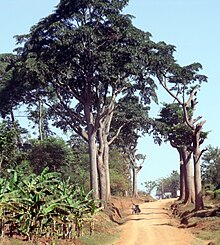Milicia excelsa
| Milicia excelsa | |
|---|---|
 |
|
| Scientific classification | |
| Kingdom: | Plantae |
| (unranked): | Angiosperms |
| (unranked): | Eudicots |
| (unranked): | Rosids |
| Order: | Rosales |
| Family: | Moraceae |
| Genus: | Milicia |
| Species: | M. excelsa |
| Binomial name | |
|
Milicia excelsa (Welw.) C.C. Berg |
|
| Synonyms | |
|
|
Milicia excelsa (commonly known as African teak, mvule or iroko) is a tree species from tropical Africa. It is one of two tree species yielding timber known as iroko, the other being Milicia regia. It is threatened by habitat loss. The seed is mainly dispersed by bats.
In a study it was seen that isolation was caused by one or more of the animals that are known for dispersal of Milicia excelsa (i.e. Bats, rodents, and birds). It is hypothesized that the ancestor slowly developed a different flowering time from its ancestor, which led to differences in selection pressure during the time of reproduction. This, over time, has resulted in the tree that we see today commonly known as Iroko. Although this is the theory that has the most evidence, it is possible for Milicia excelsa to have evolved in a different way.
African teak is a large deciduous tree growing up to 50 metres (160 ft) high. The trunk is bare lower down with the first branch usually at least 20 metres (66 ft) above the ground. It often has several short buttress roots at the base. The bark is pale or dark grey, thick but little fissured, and if it gets damaged it oozes milky latex. There are a few thick branches in the crown all fairly horizontal giving an umbrella shape. The smaller branches hang down in female trees and curve up in male trees. The leaves are 5 to 10 centimetres (2.0 to 3.9 in) long, ovate or elliptical with a finely toothed edge, green and smooth above and slightly downy beneath. Older leaves turn yellow, and all of the leaves have a prominent rectangular mesh of veins visible on the underside. The trees are dioecious. Male trees have white catkins that extend 15 to 20 centimetres (5.9 to 7.9 in) and dangle from twigs at the axils of the leaves. Female trees have flower spikes measuring 5 to 6 centimetres (2.0 to 2.4 in) long by 2 cm (0.8 in) wide, green with prominent styles. The fruit are long, wrinkled and fleshy with the small seeds embedded in the pulp.
There is evidence that some of the variation that is described above amongst individuals is due to the variation in the environment. In a study done in 2010, it was found that environmental change from different regions in Benin caused much of the variation in Milicia excelsa. Many studies have attributed this variation in growth to the differences in climate of regions. Specifically, soil characteristics and rainfall played a major role in the morphological variation of trunk growth of Milicia excelsa.
...
Wikipedia

